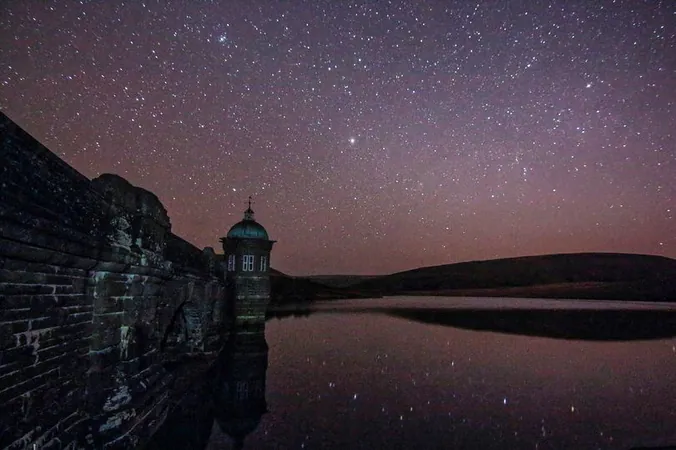
Prepare for an Astronomical Wonder: Rare Celestial Explosion Set to Dazzle the Night Sky!
2024-12-30
Author: Michael
A Rare Celestial Event
Astronomy enthusiasts, mark your calendars! A sensational celestial event is on the horizon—a spectacular star explosion that occurs only once every 80 years is anticipated to illuminate our night sky. T Cor Bor, also known as the Blaze star, is poised for a magnificent resurgence, transforming from an invisible entity into a dazzling beacon.
The Science Behind T Cor Bor
Eager stargazers are now focusing their telescopes on the Corona Borealis constellation, bracing themselves for the long-awaited reignition of this long-dormant star. When T Cor Bor bursts into life, its brightness could rival that of the North Star, creating a sight not to be missed!
To grasp the science behind T Cor Bor, it's essential to understand that this unique phenomenon consists of a white dwarf star engaging with a larger red giant star. The white dwarf, which has exhausted its nuclear fuel, draws gas from its companion, setting the stage for a potential nuclear explosion. This cosmic event may increase its typical dim magnitude from 10 to an astonishing 2.0—making it bright enough to be seen even without a telescope.
Anticipation Builds
The last eruption of T Cor Bor occurred in 1946, leaving avid astronomers in anticipation as the latest ignition was initially expected last September. Unfortunately, this stellar explosion has remained elusive. Still, vigilant observers at locations like the Dark Skies Reserve of Bannau Brycheiniog (Brecon Beacons) are closely monitoring the skies for any signs of its emergence.
Expert Insights
Dr. Jenifer Millard from Fifth Star Labs shared insights with the BBC, stating, "Currently, T Cor Bor is quite dim—magnitude 10, far beyond naked-eye visibility. To spot the area in the night sky designated for its appearance, locate The Plough constellation and trace its handle towards Arcturus. Just west of Arcturus lies the Corona Borealis constellation, which houses T Cor Bor. It is poised to shine brighter in the near future.”
Dr. Millard also noted that the star will only be visible to the naked eye for a limited duration of time. For those equipped with binoculars or telescopes, the visibility extends a bit longer, enhancing the excitement surrounding this temporary cosmic display.
Monitoring the Event
Astrophysicist Elizabeth Hays, who is monitoring the event using NASA's Fermi gamma-ray space telescope, expressed her enthusiasm: “We know it’s set to happen; we just can’t pinpoint the exact timing.” The countdown is on, and it seems to be a game of cosmic patience!
David Williams-Baldwin, an astronomer who appeared on BBC Breakfast, conveyed his anticipation, stating, “I’ve been waiting patiently for the past couple of years to witness its explosion. This is an unusual event, as it typically produces a precursor dip approximately a year in advance. It’s overdue now—roughly three months late from our original estimates!”
How to Witness the Event
Experts recommend that anyone interested in witnessing this extraordinary event should look to The Plough at night, searching for a bright, orange star located in the western sky. This bright spectacle, positioned at the bottom left of the Corona Borealis constellation, will leave you in awe.
Conclusion
Don't miss this once-in-a-lifetime opportunity to witness T Cor Bor shine brilliantly in our night sky. Stay tuned for updates and alerts from the amateur astronomy community, and prepare to be enchanted by the wonders of the universe!



 Brasil (PT)
Brasil (PT)
 Canada (EN)
Canada (EN)
 Chile (ES)
Chile (ES)
 Česko (CS)
Česko (CS)
 대한민국 (KO)
대한민국 (KO)
 España (ES)
España (ES)
 France (FR)
France (FR)
 Hong Kong (EN)
Hong Kong (EN)
 Italia (IT)
Italia (IT)
 日本 (JA)
日本 (JA)
 Magyarország (HU)
Magyarország (HU)
 Norge (NO)
Norge (NO)
 Polska (PL)
Polska (PL)
 Schweiz (DE)
Schweiz (DE)
 Singapore (EN)
Singapore (EN)
 Sverige (SV)
Sverige (SV)
 Suomi (FI)
Suomi (FI)
 Türkiye (TR)
Türkiye (TR)
 الإمارات العربية المتحدة (AR)
الإمارات العربية المتحدة (AR)